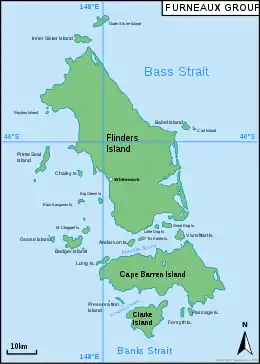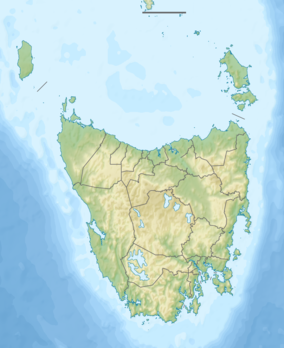Furneaux Group
The Furneaux Group is a group of approximately 100 islands located at the eastern end of Bass Strait, between Victoria and Tasmania, Australia. The islands were named after British navigator Tobias Furneaux, who sighted the eastern side of these islands after leaving Adventure Bay in 1773 on his way to New Zealand to rejoin Captain James Cook.[1] Navigator Matthew Flinders was the first European to explore the Furneaux Islands group, in the Francis in 1798, and later that year in the Norfolk.[2]
 | |
 Furneaux Group | |
| Etymology | Tobias Furneaux |
|---|---|
| Geography | |
| Location | Bass Strait |
| Coordinates | 40°06′54″S 148°06′54″E |
| Total islands | approx. 100 |
| Major islands | Flinders Island, Cape Barren Island, and Clarke Island |
| Area | 2,010.3 km2 (776.2 sq mi) |
| Administration | |
| State | Tasmania |
| Local government | Flinders Council |
| Demographics | |
| Population | 795 |
The largest islands in the group are Flinders Island, Cape Barren Island, and Clarke Island. The group contains five settlements: Killiecrankie, Emita, Lady Barron, Cape Barren Island, and Whitemark on Flinders Island, which serves as the administrative centre of the Flinders Council. There are also some small farming properties on the remote islands.
After seals were discovered there in 1798, the Furneaux Group of islands became the most intensively exploited sealing ground in Bass Strait.[3] A total of 29 islands in the Furneaux Group have been found to have some tangible link with sealing in the 19th century.[4]
The Aboriginal matriarch, Dolly Dalrymple, was born on the Furneaux Islands. Her mother was one of two Aboriginal women who had been kidnapped from northern Tasmania by the sealer George Briggs.[5]
King Island, at the western end of Bass Strait, is not a part of the group.
Administration
The Furneaux Group forms the Flinders Council together with the groups of islands to the northwest: the Kent Group, Hogan Island Group, Curtis Group, and the Tasmanian part of the Wilsons Promontory Islands.
Islands in the Group
| Island | Capital | Other cities | Area | Population | |
|---|---|---|---|---|---|
| km2 | sq mi | ||||
| Furneaux Group | Whitemark | Lady Barron, The Corner, Emita, Killiecrankie | 2,010.3 | 776.2 | 795 |
| Babel Island Group | 5.01 | 1.93 | 0 | ||
| Babel Island | 4.4 | 1.7 | 0 | ||
| Cat Island | 0.39 | 0.15 | 0 | ||
| Fifty Foot Rock | 0.02 | 0.0077 | 0 | ||
| Other | 0 | 0 | 0 | ||
| Storehouse Island | 0.2 | 0.077 | 0 | ||
| Badger Island Group | Badger Island | Mount Chappell Island | 18.15 | 7.01 | 3 |
| Badger Island | South East Point | 13.5 | 5.2 | 1 | |
| Goose Island | 1.09 | 0.42 | 0 | ||
| Inner Little Goose Island | 0.045 | 0.017 | 0 | ||
| Little Badger Island | 0.025 | 0.0097 | 0 | ||
| Little Goose Island | 0.036 | 0.014 | 0 | ||
| Mount Chappell Island | 3.45 | 1.33 | 2 | ||
| Other | Beagle Island | North West Mount Chappell Islet | 0.004 | 0.0015 | 0 |
| Bass Pyramid | Bass Pyramid | 0.025 | 0.0097 | 0 | |
| Big Green Island Group | Big Green Island | East Kangaroo Island | 4.1 | 1.6 | 6 |
| Big Green Island | 1.57 | 0.61 | 4 | ||
| Chalky Island | 0.41 | 0.16 | 0 | ||
| East Kangaroo Island | 1.57 | 0.61 | 2 | ||
| Isabella Island | 0.14 | 0.054 | 0 | ||
| Little Chalky Island | 0.05 | 0.019 | 0 | ||
| Mile Island | 0.04 | 0.015 | 0 | ||
| Other | 0.14 | 0.054 | 0 | ||
| Cape Barren Island | The Corner | 478.4 | 184.7 | 67 | |
| Clarke Island | 82 | 32 | 1 | ||
| Craggy Island | Craggy Island | 0.389 | 0.150 | 0 | |
| Flinders Island | Whitemark | Lady Barron | 1,367 | 528 | 700 |
| Franklin Sound Islands Important Bird Area | Great Dog | Tin Kettle | 21.362 | 8.248 | 14 |
| Anderson Island | 1.66 | 0.64 | 0 | ||
| Boxen Island | 0.13 | 0.050 | 0 | ||
| Briggs Islet | 0.034 | 0.013 | 0 | ||
| Doughboy Island | 0.17 | 0.066 | 0 | ||
| Great Dog Island | Great Dog Island | 3.75 | 1.45 | 10 | |
| Lady Barron Island | 0.01 | 0.0039 | 0 | ||
| Little Anderson Island | 0.13 | 0.050 | 0 | ||
| Little Dog Island | Little Dog Island | 0.83 | 0.32 | 0 | |
| Little Green Island | 0.87 | 0.34 | 0 | ||
| Long Island | 3.13 | 1.21 | 0 | ||
| Neds Reef | 0.04 | 0.015 | 0 | ||
| Other | Spences Islands | Big Black Reef, GVH Rock, Mid Woody Islet, Ram, Apple Orchard Point, Billy Goat Reefs, Fisher Island, Samphire Island | 0.253 | 0.098 | 0 |
| Oyster Rocks | East Oyster | West Oyster | 0.07 | 0.027 | 0 |
| Pelican Island | 0.07 | 0.027 | 0 | ||
| Puncheon Island | Puncheon Island | 0.185 | 0.071 | 1 | |
| Tin Kettle Island | Tin Kettle | 1.86 | 0.72 | 2 | |
| Vansittart Island | Bates Bay | House Bay | 8.17 | 3.15 | 1 |
| Inner Sister Island | 7.48 | 2.89 | 0 | ||
| Other | Little Island | Shag Rock | 0 | 0 | 0 |
| Outer Sister Island | Outer Sister Island | 5.45 | 2.10 | 0 | |
| Pasco Island Group | Roydon Island | 1.1 | 0.42 | 0 | |
| Marriott Reef | 0.034 | 0.013 | 0 | ||
| Middle Pasco Islands | 0.084 | 0.032 | 0 | ||
| North Pasco Island | 0.28 | 0.11 | 0 | ||
| Other | 0.122 | 0.047 | 0 | ||
| Roydon Island | 0.37 | 0.14 | 0 | ||
| South Pasco Island | 0.21 | 0.081 | 0 | ||
| Passage Island Group | Passage Island | 4.47 | 1.73 | 2 | |
| Forsyth Island | 1.67 | 0.64 | 0 | ||
| Gull Island | 0.085 | 0.033 | 0 | ||
| Low Islets | 0.02 | 0.0077 | 0 | ||
| Moriarty Rocks | 0.025 | 0.0097 | 0 | ||
| Other | Battery Island | 0.017 | 0.0066 | 0 | |
| Passage Island | Passage Island | 2.53 | 0.98 | 2 | |
| Spike Island | Spike Island | Little Spike Island | 0.123 | 0.047 | 0 |
| Preservation Island Group | Preservation Island | 2.37 | 0.92 | 2 | |
| Key Island | 0.06 | 0.023 | 0 | ||
| Night Island | 0.026 | 0.010 | 0 | ||
| Other | 0.007 | 0.0027 | 0 | ||
| Preservation Island | Preservation Island | Horseshoe Bay | 2.08 | 0.80 | 2 |
| Rum Island | 0.197 | 0.076 | 0 | ||
| Prime Seal Island Group | Prime Seal Island | 12.8 | 4.9 | 0 | |
| Bird Island | 0.015 | 0.0058 | 0 | ||
| Low Islets | South Low | Middle Low, North Low | 0.35 | 0.14 | 0 |
| Other | 0.075 | 0.029 | 0 | ||
| Prime Seal Island | Peacock Bay | South Bay | 12.2 | 4.7 | 0 |
| Wybalenna Island | 0.16 | 0.062 | 0 | ||
| Sentinel Island | 0.1 | 0.039 | 0 | ||
| Wright Rock | 0.094 | 0.036 | 0 | ||
| Furneaux Group | Whitemark | Lady Barron, The Corner, Emita, Killiecrankie | 2,010.3 | 776.2 | 795 |
Geology
The islands contain granite from the Devonian period, as well as unconsolidated limestone and sand from Cenozoic periods. During the last ice age, a land bridge joined Tasmania to the Australian mainland through this group of islands.
References
- Cumpston, J. S. (1973). First visitors to Bass Strait. Canberra: Roebuck Society. ISBN 0-9500858-8-X.
- Flinders, Matthew (1801). Observations on the coasts of Van Diemen's, Land on Bass's Strait and its islands, and on part of the coasts of New South Wales; intended to accompany the charts of the late discoveries in those countries.
- Kostoglou, Parry (1996). Sealing in Tasmania historical research project (First ed.). Hobart: Parks and Wildlife Service. pp. 90–1.
- Kostoglou, p.91.
- McFarlane, Ian (2005). Dalrymple, Dolly (c. 1808 - 1864). p. 94.
{{cite book}}:|work=ignored (help)